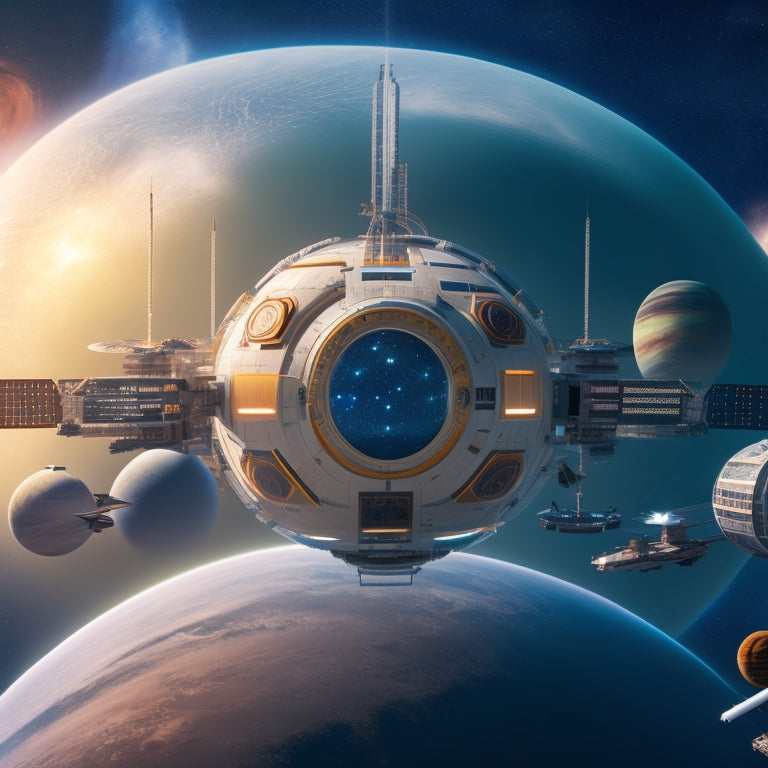
What's the Best Solar System for Planetary Exploration
Share
You're searching for a solar system that mirrors the ideal conditions of our own, with planets boasting habitable zones, stable atmospheres, and Earth-like compositions that could support life. Proximity to Earth is essential, as distance affects mission feasibility and resource allocation. Systems with similarities to our own, such as K2-18b and TRAPPIST-1e, offer promising leads. Unique features like colorful atmospheres and geological diversity provide significant understandings into planetary evolution. As you investigate the most promising candidates, you'll uncover intriguing possibilities that could redefine our comprehension of planetary exploration and the search for life beyond our solar system.
Key Takeaways
- Prioritize solar systems with planets in habitable zones, where temperatures allow for liquid water, to increase chances of finding life.
- Consider systems with stable atmospheres, similar to Earth's, to ensure a consistent climate and effective regulation of temperature and radiation.
- Proximity to Earth is crucial, as it affects the feasibility and practicality of exploration missions, with ideal distances allowing for efficient resource use.
- Look for systems with celestial mechanics and planetary atmospheres resembling Earth's, as they increase the likelihood of finding life-supporting conditions.
- Identify unique planetary features, such as colorful atmospheres or geological diversity, to gain insights into a planet's composition, evolution, and potential for life.
Ideal Conditions for Life
As you venture into the search for life beyond Earth, ideal conditions become a essential aspect to focus on.
You're not just looking for any planet; you're seeking one that can support life as we understand it. That means zeroing in on habitable zones, where temperatures are just right for liquid water to exist. Too close to the star, and the planet's surface will be scorched; too far, and it'll be a frozen wasteland.
Atmospheric conditions are equally significant. A stable atmosphere is crucial for maintaining a consistent climate, which in turn allows life to thrive.
You'll want to identify planets with atmospheric compositions similar to Earth's, featuring a mix of gases like oxygen, nitrogen, and carbon dioxide. These conditions will also influence the planet's ability to regulate its temperature and protect its surface from harmful radiation.
Distance From Earth Matters
The proximity of a planet to Earth considerably impacts the feasibility and practicality of exploration missions. You're well aware that distance affects the duration and cost of space travel. The farther away a planet is, the more resources you'll need to allocate for propulsion, life support, and communication.
Interstellar travel, for instance, poses significant logistical challenges due to the vast distances involved.
Gravitational influences also come into play. A planet's proximity to Earth affects the gravitational forces acting on your spacecraft. Closer planets require more energy to escape Earth's gravitational pull, while farther planets demand more fuel to overcome the Sun's gravitational influence.
You must consider these factors when designing your mission path and payload capacity.
When selecting a solar system for planetary exploration, you should prioritize those with planets at an ideal distance from Earth. This allows for more efficient use of resources, reducing mission costs and duration.
Solar System Similarities
Your search for the best solar system for planetary exploration leads you to contemplate systems with similarities to our own.
You're looking for a system that mirrors our own regarding planetary atmospheres and celestial mechanics. By doing so, you can increase the chances of locating life beyond Earth.
Similarities in planetary atmospheres are vital, as they provide a habitable environment for life to thrive. You want to find a system with planets that have atmospheres composed of gases similar to those found on Earth, such as nitrogen, oxygen, and carbon dioxide.
This will increase the likelihood of finding life-supporting conditions.
Regarding celestial mechanics, you're looking for a system with a stable and orderly arrangement of planets, similar to our own. This will guarantee that the planets' orbits are stable, allowing for the development of life.
A system with similarities to our own will provide the best conditions for planetary exploration, increasing the chances of uncovering life beyond our planet.
Unique Planetary Features
During your quest for the best solar system for planetary exploration, you'll want to identify unique planetary features that set a system apart from others.
These distinguishing characteristics can greatly enhance the scientific worth of your mission.
Colorful atmospheres, for instance, can provide important understandings into a planet's composition and evolution. The presence of atmospheric gases like methane, ammonia, or sulfuric acid can indicate geological activity, biological processes, or even the existence of extraterrestrial life.
Geological diversity is another critical aspect to evaluate.
Systems featuring planets with diverse terrains, such as volcanoes, canyons, or impact craters, offer a wealth of information about their formation and evolution. These features can also provide hints about the system's history, including potential asteroid impacts or tectonic activity.
The Most Promising Candidates
Beyond our celestial neighborhood, several solar systems have garnered attention for their extraordinary planetary features, making them prime targets for investigation. You're likely wondering which ones top the list.
In the domain of exoplanet research, scientists have identified a few stellar systems that tick most of the habitability criteria boxes. Take K2-18b, for instance. This super-Earth orbits a small, cool star, and its surface temperature might be suitable for liquid water.
Another promising candidate is TRAPPIST-1e, one of seven Earth-sized planets surrounding an ultracool dwarf star. Three of these planets are thought to be within the star's habitable zone, increasing the chances of finding life.
You might also be interested in LHS 1140b, a massive terrestrial planet orbiting a small, cool star. Its surface temperature and atmospheric composition suggest it could support liquid water and life.
These systems are just a few examples of the many promising candidates waiting to be investigated further. As you investigate deeper into the world of exoplanet research, you'll uncover more intriguing possibilities.
Frequently Asked Questions
Can Robots Replace Humans in Planetary Exploration?
You'll find that robots excel in planetary exploration's repetitive, high-risk tasks, leveraging their advanced capabilities in data collection and analysis. However, human intuition remains essential for critical decision-making and complex problem-solving, making a hybrid approach the most effective strategy.
How Long Do Planetary Exploration Missions Typically Last?
You'll find that mission duration varies greatly, depending on exploration objectives; typically, you're looking at anywhere from a few months to several years, with some missions even lasting over a decade, like Voyager 1's ongoing 44-year expedition.
Do Planetary Exploration Missions Have a Fixed Budget?
You'll find that NASA's average mission cost is around $1 billion; surprisingly, you'll face budget constraints, as funding sources like government allocations and private investors often fluctuate, making it essential to optimize resource allocation for successful planetary exploration.
Can Planetary Exploration Be Done With Existing Technology?
You can tackle planetary exploration with existing technology, but you'll still face significant exploration challenges, such as propulsion limitations, communication delays, and harsh environmental conditions, which will require innovative problem-solving and strategic resource allocation.
Are Private Companies Involved in Planetary Exploration?
You're witnessing a surge in private companies like SpaceX, Blue Origin, and Planetary Resources driving planetary exploration forward through private partnerships and commercial investments, leveraging state-of-the-art tech to accelerate exploration and expansion.
Conclusion
As you venture into the vast expanse of our celestial neighborhood, the quest for the perfect solar system for planetary investigation becomes a siren's call. Amidst the cosmos, a delicate balance of ideal conditions, proximity to Earth, and unique planetary features converges to beckon us to the most promising candidates. The allure of revelation whispers secrets of life beyond our terrestrial bounds, tantalizingly close yet hauntingly elusive. Will you answer the call to traverse, to decipher the mysteries of the universe, and to perhaps, stumble upon a reflection of ourselves among the stars?
Related Posts
-

Integrating Solar Panels Into Home Design
Integrating solar panels into your home design greatly enhances energy efficiency and lowers utility bills while addi...
-

Solar Power Backup Solutions During Outages
Solar power backup solutions guarantee you have reliable energy during outages, providing essential power when the gr...
-

Cost-Effective Solar Solutions for Rural Homes
Cost-effective solar solutions can alter your rural home by enhancing energy independence and slashing utility bills....


